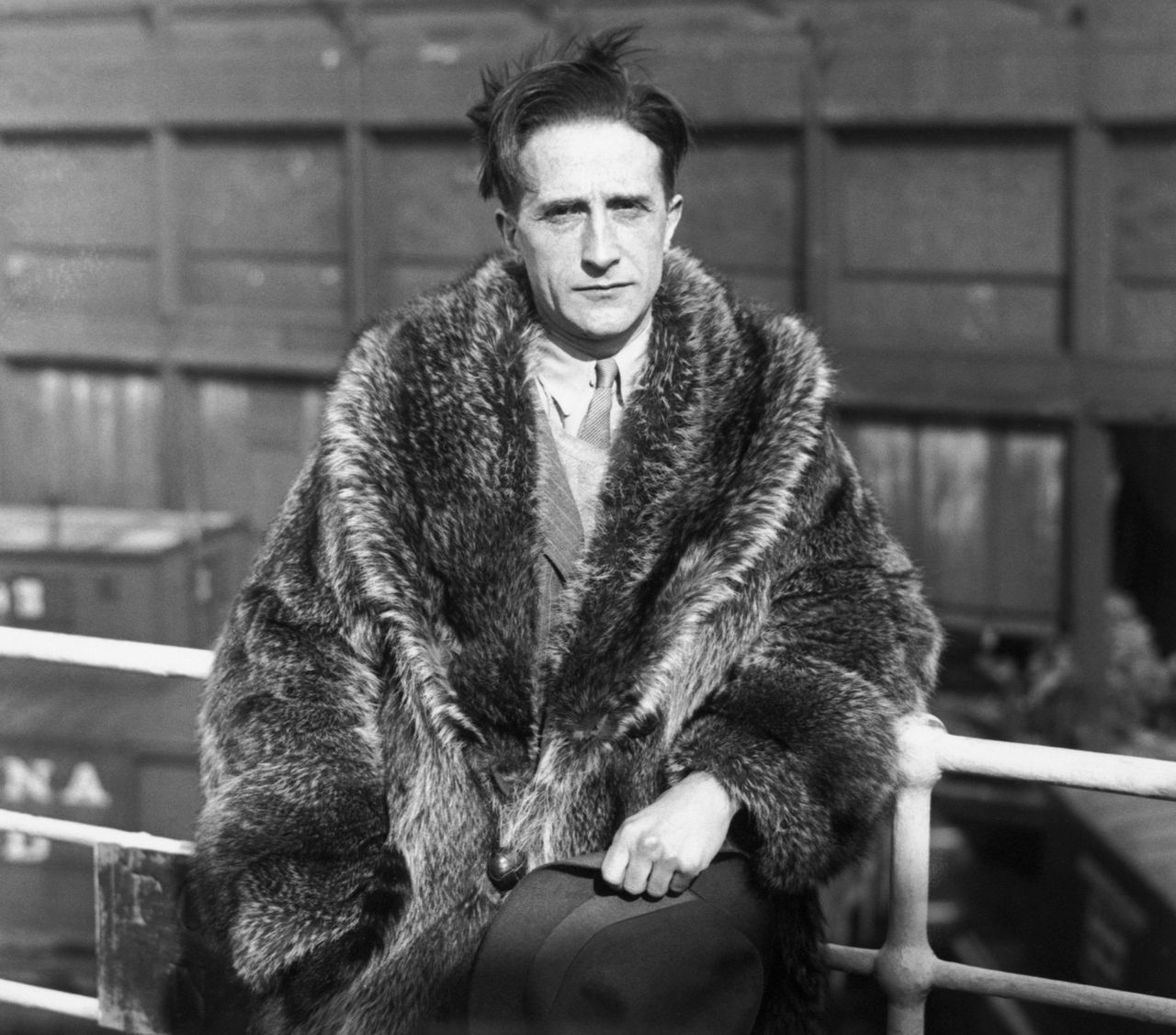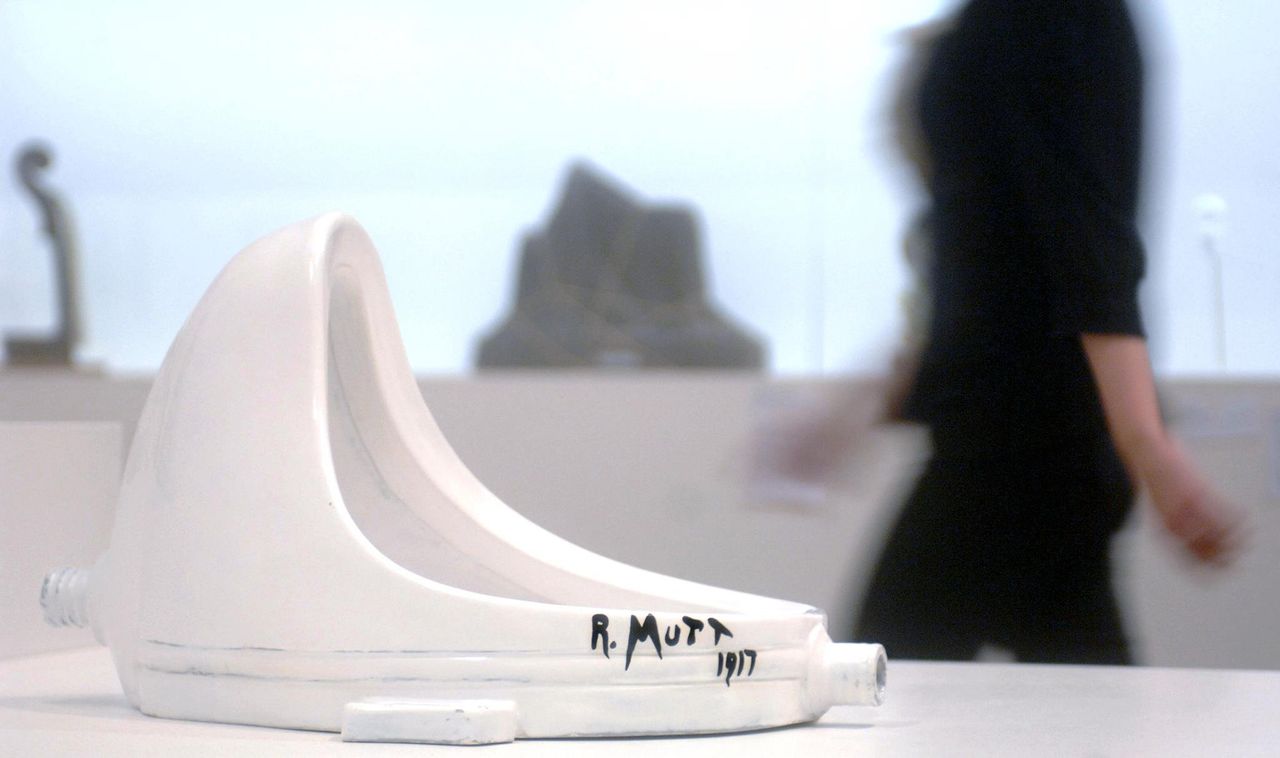One hundred years ago, a man named Marcel Duchamp changed the course of art. All it took was a pseudonym, a urinal and a penchant for sticking it to the man. But mostly, the urinal.
On April 9, 1917, the French-born Duchamp anonymously submitted an artwork for consideration to an exhibition hosted by the so-called Society of Independent Artists in New York. Being an open show without a jury, the expectation was that his work, whatever it may be, would be accepted as long as the artist paid the exhibition’s entrance fee. So Duchamp, a historic prankster, sent “Fountain,” a white porcelain urinal purchased from a store that sold plumbing fixtures, on which he’d scribbled the name “R. Mutt” and a date.
The Society, of which Duchamp was a member, promptly rejected the work. “The ‘Fountain’ may be a very useful object in its place, but its place is not in an art exhibition and it is, by no definition, a work of art,” the group wrote in a statement issued to press at the time. Duchamp, disgusted by the Society’s decision, resigned in protest.
“Duchamp didn’t make ‘Fountain,’” Matthew Affron, a curator of modern art at the Philadelphia Museum of Art, reiterated in a conversation with The Huffington Post. “It was a manufactured object ― an ordinary urinal purchased in a hardware store.”
But it was this ordinary urinal that would spark a global conversation about the meaning of the word “art.”
A few days after the rejection, the great Alfred Stieglitz photographed Duchamp’s urinal, creating the image that would live on in an avant-garde magazine named The Blind Man, published by Duchamp and his friends. In its May issue, the magazine featured unsigned essays defending the work and deriding the Society, with one particularly adamant series of lines reading: “Whether Mr. Mutt with his own hands made the fountain or not has no importance. He CHOSE it. He took an ordinary article of life, placed it so that its useful significance disappeared under the new title and point of view — created a new thought for that object.”
A century later, replicas and photos of “Fountain” are among the most studied objets d’art. Decades after his death in 1968, Duchamp, dishonored by a group of artists he saw as hypocritical, was once dubbed “the 20th century’s cleverest artist.” His urinal is considered by many to be “the most influential piece of modern art.”

The Philadelphia Museum, which houses the world’s largest collection of works by Duchamp, is one of the many art havens celebrating the 100th anniversary of “Fountain,” undoubtedly the most famous piece of rejected art.
Yet one particular aspect of the centenary celebrations aroused suspicion. It was announced, via a curious press release, that museums including the Philadelphia Museum, the Centre Pompidou in Paris, the Museum of Modern Art in New York, the Tate Modern in London, the Haus der Kulturen der Welt in Berlin and several other famous institutions would allow access ― free of charge, for one hour, on April 9 ― to anyone with the secret password.
News of the celebration spread across the internet, and so did doubt. Representatives from a few museums including the Museum of Modern Art told Artnet News that they couldn’t confirm their institution’s participation. (In a later email to HuffPost, the museum was clear: “MoMA is not participating in the Duchamp ticket offer.”)
“I kind of like the idea that this is being conceived of as some sort of meta prank, where it’s not even clear if this is going to be happening on April 9,” Thomas Girst, the man behind the press release in question, explained to HuffPost over the phone. “But I am happy to confirm that after many months of dialogues and conversations with these cultural institutions worldwide, they really openly embrace and support the idea of celebrating [’Fountain’].”
Girst is BMW’s head of cultural engagement, as well as the author of the 2014 book The Duchamp Dictionary. “I write my Duchamp books at night,” he explained. “It’s been a fascination for over 20 years and it just doesn’t go away.”
MoMA’s statement surprised Girst, as he’s the man who’s taken months to reach out to a hefty list of museums to organize the global celebration.
The password, he says, is real.
It’s “R. Mutt” or “Richard Mutt,” the pseudonymous name Duchamp signed to “Fountain.” Whisper it to certain museum attendants on April 9 from 3 p.m. to 4 p.m. in their respective time zones, and you’ll be able to stroll past free of charge. All in the name of Duchamp.
(See a complete list of museums below. And, despite Girst’s claims that MoMA had signed on to participate, the museum is no longer included.)

Beyond the password, Girst and a slew of museums have scheduled accompanying programming meant to honor the 100-year-old urinal that shocked the art world. The Philadelphia Museum, for one, opened an exhibition titled “Marcel Duchamp and the ‘Fountain’ Scandal” on April 1.
“He called this type of work readymade, borrowing a term for clothing sold ready-to-wear rather than made-to-order,” curator Affron told HuffPost. “Working with manufactured objects allowed him to remake the rules of artistic creation and to overturn prevailing ideas about the value of original works.”
Duchamp had reason to detest prevailing ideas. He never truly explained his decision to test the Society in 1917, but many scholars, like those at the Tate Modern, speculate that it had to do with his experience with the Salon des Indépendants in Paris, before he made his move to the United States. When, in 1912, he submitted an artwork called “Nude Descending a Staircase, No. 2,” Salon organizers unhappy with the subject and title succeeded in convincing Duchamp to withdraw his painting. Duchamp had felt censored then, and censored once again by the independents of New York.
“Art history has consistently decided upon the virtues of a work of art through considerations completely divorced from the rationalized explanations of art,” Duchamp declared in a quote included in Girst’s Duchamp Dictionary.
Both Affron and Girst confirm that “Fountain,” long thought to have been tossed in the garbage sometime after its debut, changed the course of art, “for the better and for the worse,” Girst noted.
“For the better, he seems today as a patron saint who was going up against the Western canon,” Girst said. “I think he embodies the revolutionary spirit unlike any other. I think he can be a really encouraging and liberating figure for young artists, if they decide not to walk in his shadow. Not to replicate what he has already done.” He cited Jeff Koons and Robert Rauschenberg as artists who’ve successfully followed suit.
For the worse, according to Girst, artists nowadays “think they can do anything and get away with it. What was an iconoclastic gesture by Marcel Duchamp in 1917, has slowly become an icon of modern art. To sign a mass-produced object these days is just a shallow gesture, basically not taking into account the radiating intelligence of Duchamp when it comes to creating works of art.”
One hundred years later, the art world takes the good with the bad, though Girst wasn’t about to name any offending names. And if the good includes one hour’s worth of free art, courtesy of museums across the globe, we can’t complain.
While all institutions of modern and contemporary art around the world are encouraged to take part in Girst’s initiative, he confirmed the following museums will afford patrons free entry on April 9 from 3 to 4 p.m. with use of the password “R. Mutt” or “Richard Mutt”: The Philadelphia Museum of Art, Philadelphia; The Israel Museum, Jerusalem; Serpentine Galleries, London; Tate Modern, London; Haus der Kulturen der Welt, Berlin; Stedelijk Museum, Amsterdam; Hamburger Bahnhof, Berlin; Centre Pompidou, Paris; The National Museum of Modern Art, Kyoto; Moderna Museet, Stockholm; Staedel Museum, Frankfurt; Ullens Center for Contemporary Art, Beijing; Kunsthalle Basel, Basel; Lenbachhaus, Munich; Staatsgalerie Stuttgart, Stuttgart; Staatliches Museum Schwerin, Schwerin; Museum Ludwig, Cologne.
Additional programming for #Fountain100 includes: “The Fountain Archives,“ at Centre Pompidou in Paris, “Marcel Duchamp and the Fountain Scandal” at the Philadelphia Museum of Art and “Fountain: 1917-2017“ at the National Museum of Modern Art in Kyoto.

